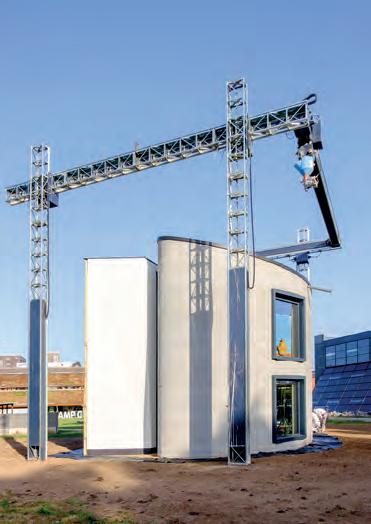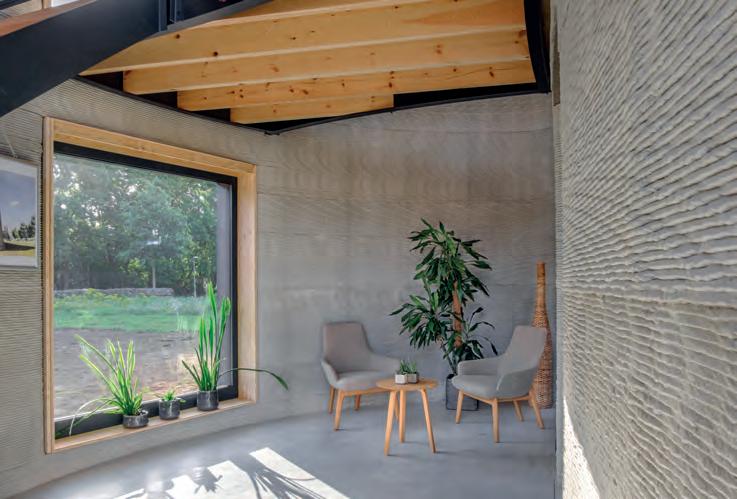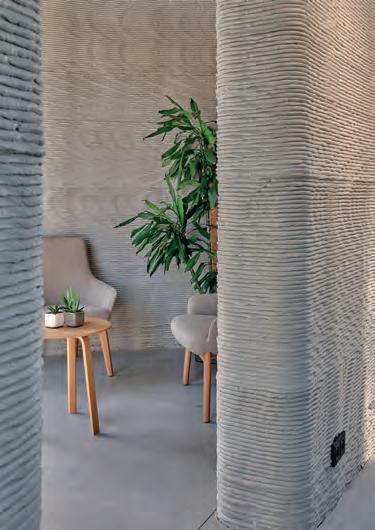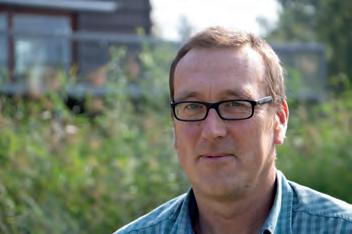
8 minute read
Kamp C
Photo: © Kamp C
Kamp C, the Westerlo-based provincial Centre for Sustainability and Innovation in Construction, printed a house using the largest 3D concrete printer in Europe. The 90-square metre dwelling was printed in one piece with a fixed printer. This is a world first.
Advertisement
You can find Flanders’ first 3D-printed model home on the premises of Kamp C in Westerlo (Belgium). The two-storey house is eight metres tall and has a floor area of 90 square metres, the average size of a terraced house in this region. “What makes this house so unique, is that we printed it with a fixed 3D concrete printer,” said Emiel Ascione, the project manager at Kamp C. “Other houses that were printed around the world only have one floor. In many cases, the components were printed in a factory and were assembled on-site. We, however, printed the entire building envelope in one piece on-site.
The house was printed as part of the European C3PO with financing from ERDF (the European Regional Development Fund). With this feat, the project partners hope to raise interest

Photo: © Kamp C Photo: © Kamp C

in the building industry about the use of 3D concrete printing as a building technique.
Kathleen Helsen, the Provincial Deputy for Housing and the President of Kamp C said: “The building industry has expressed plenty of interest. 3D printing in construction is experiencing an uptick around the world. Several possibilities, including the printing of provisional housing and even complete apartments, are already being implemented, but this technology is still very novel in Flanders. At the same time, the construction industry is facing unprecedented challenges: we must reduce our consumption of materials and energy, reduce CO2 emissions and the waste stream, the demand for high-quality and affordable housing is on the rise, and so on. At Kamp C, we believe that new technologies, such as 3D concrete printing, can help provide a response. That is why we created this unique location on our site, where construction companies can experiment with 3D printing, together with research and education institutions.”
Three times sturdier
The printed house is three times sturdier than a house built with quick build bricks. “The material’s compressive strength is three times greater than that of the conventional quick build brick,” explained Marijke Aerts, the project manager at Kamp C.
This first house is a test. The researchers will now check whether solidity is retained over time. Besides the fibres in the concrete, the amount of wire-mesh reinforcement used is extremely limited. As a result of the printing technology used, formwork was redundant, saving an estimated sixty percent on material, time, and budget. In the future, an entire house could be printed in just under two days. If you add up all the days, it took just three weeks to print the house at Kamp C.
Model home
The model home was designed to showcase the technology and the potential of 3D printing. “We printed an overhang, it


has heavily curved walls, different types of walls…We also incorporated solutions to the traditional thermal bridge, eliminating cold bridges altogether,” said Ascione. “We developed a lowenergy house, with all the mod cons, including floor and ceiling heating, special façade solar panels and a heat pump, and we will also be adding a green roof.” “When we started to build it, we had no idea which use the building would have. Our aim was to print the floor area, height, and shape of an average contemporary home, in the form of a model home with multipurpose options. This is a principle of circular building. The building can be used as a house, a meeting space, an office, or an exhibition space. People can visit the house after making an appointment,” said Piet Wielemans, who is an architect at Kamp C.
Project
The house is part of the European C3PO project, which aims to accelerate the transition to this innovative technology in Flanders. Eight partners, from the business community and the scientific community, have joined forces for the project. They are Beneens, ETIB/ CONCRETE HOUSE, Groep Van Roey, Thomas More, Trias architecten, Ghent University and Vicré. Saint-Gobain Weber is also contributing to the project. This article is part of the C3PO project. The partners received € 668,320 in European grants through C3PO, an ERDF project (‘Co-creation: 3D-printing with companies). The project is also a part of GTI Kempen (GTI stands for Gerichte Territoriale Investering in Dutch, or an integrated territorial investment strategy for a specific region, combining various European funds and programmes).

Photo: © Jasmien Smets

Photo: © Jasmien Smets Photo: © Jasmien Smets

PROJECT DATA
Project Name: Kamp C: Centre for Sustainability and Innovation in Construction Location: Westerlo, Belgium Type: Two-storey house Lead Partner: Kamp C Partners: Beneens, ETIB/CONCRETE HOUSE, Groep Van Roey, Thomas More, Trias architecten, Ghent University, Vicré and Saint-Gobain Weber. 3D Printer Specialist: COBOD (Denmark) Completion: 2020
Interview with Piet Wielemans, Architect, Kamp C | Centre Sustainability & Innovation
SEAB: Give us a brief overview of this 3D printed building project Kamp C: Centre for Sustainability and Innovation in Construction.
PIET: The house was printed as part of the European C3PO-project with financing from ERDF (the European Regional Development Fund). With this feat, the project partners hope to raise interest in the building industry about the use of 3D concrete printing as a building technique.
The building industry has expressed plenty of interest. 3D printing in construction is experiencing an uptick around the world. Several possibilities, including the printing of provisional housing and even complete apartments, are already being implemented, but this technology is still very novel in Flanders. At the same time, the construction industry is facing unprecedented challenges: we must reduce our consumption of materials and energy, reduce CO2 emissions and the waste stream, the demand for high-quality and affordable housing is on the rise, and so on. At Kamp C, we believe that new technologies, such as 3D concrete printing, can help provide a response. That is why we created this unique location on our site, where construction companies can experiment with 3D printing, together with research and education institutions.
SEAB: Compared to conventional construction, what advantages did 3D printing technology offer to this project?
PIET: The model home was designed to showcase the technology and the potential of 3D printing. We printed an overhang, it has heavily curved walls, different types of walls. The big advantage of 3D concrete printing lies mainly in the CO2 savings: no formwork is required by printing, which saves a huge amount of time, material and labour. And by printing it without formwork, the designer gets enormous freedom of design at a much cheaper price.
The printed house is also three times sturdier than a house built with quick build bricks. The material’s compressive strength is three times greater than that of the conventional quick build brick. This first house is a test. The researchers will now check whether solidity is retained over time.
Besides the fibres in the concrete, the amount of wire-mesh reinforcement used is extremely limited. As a result of the printing technology used, formwork was redundant, saving an estimated 60 percent on material, time, and budget. In the future, an entire house could be printed in just under two days. If you add up all the days, it took just three weeks to print the house at Kamp C.
We also incorporated solutions to the traditional thermal bridge, eliminating cold bridges altogether. We developed a low-energy house, with all the mod cons, including floor and ceiling heating, special facade solar panels and a heat pump, and we will also be adding a green roof.
SEAB: What were some of the issues and limitations that you faced when using 3D printing technology for this project?
PIET: As we got to know the printer better, the design was systematically adapted to the capabilities of the printer. More organic and vertically curved shapes appeared to be less possible, also due to the limitations of the 3D concrete composition. The walls in the final result are 2D curved. However, an overhang of 7° was possible. In the meantime, both the printer and the concrete composition have already been improved, which could now open up more possibilities.
SEAB: How closely did you work with the 3D concrete printer specialist to realise this project?

Piet Wielemans. Photo: © Kamp C
PIET: Eight partners, from the business community and the scientific community, have joined forces for the project. They are Beneens, ETIB/ CONCRETE HOUSE, Groep Van Roey, Thomas More, Trias architecten, Ghent University and Vicré. The printer was built by COBOD (Denmark), Saint-Gobain Weber was also contributing to the project. To stimulate 3D-printing in the construction world, all partners were joined to get a maximum exchange of knowledge. This project has to inspire and convince them to participate in the necessary changes. Both the construction world and educational as scientific institutions need a location to experiment. And this is what happens at Kamp C: there is a full experimentation with this construction technique.
SEAB: In your opinion, what kind of future do you see for 3D printed buildings?
PIET: In the very near future, it will be possible to build houses at a much cheaper price in a very limited time. The CO 2 reduction is also gigantic (more than 50 percent), and it gives the designers enormous freedom of design. Together with the evolutions in parametric design, unique buildings can be printed quickly and adapted to the needs of the building owners and the environment.








